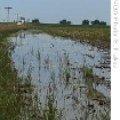Although rivers did not overflow here, this part of Iowa was hit by heavy rains that damaged newly planted crops and left some fields too wet to work.
Mondamin, Iowa farmer says some of what he planted earlier was damaged by water.
"This would have been planted around the end of April and it is behind. I mean you can see how uneven it is. Where the water stands, of course, it stunts the growth," he said. But he says the prospect of a higher price has sent him out to plant some more.
"I hope it is not a false optimism, but yeah there is more incentive with the price of the grain," he added. Neighboring farmer Larry King says profits from higher prices may be limited by higher input costs.
"The problem is as prices go up, our inputs go up as well. Fertilizer has gone up. Fuel has gone up," he explained. He says re-planting this late in the season will also limit his yield per section of land.
"I will probably get 25 to 35 bushels planting by this July 1 compared to 45 to 65 bushels," he noted. Another factor pushing corn prices higher is the use of the grain for ethanol. Even before the recent floods, higher corn prices had caused livestock feed to jump in price. Texas Governor Rick Perry says the higher costs are driving some of his state's ranchers out of business and he is asking Congress to reduce the ethanol mandate by 50 percent. "Although ethanol and the Renewable Fuel Standard mandate looked like a good idea five years ago, it's no longer a good idea," he said. "It's hurting Americans. It's hurting our families." Brian Jennings is Vice President of the Sioux Falls, South Dakota-based American Coalition for Ethanol, an ethanol industry advocate organization, says several independent studies have shown that ethanol-driven demand has only a small impact on corn prices.
"Ethanol's role in food price inflation is about two to three percent, that means about 97 percent of the food price problem we have today is something other than biofuels. Now, primarily, this is a function of the record-high energy prices that we have," he explained. He says it is too soon to say if a shortage of corn caused by the floods will affect ethanol producers.
"It is something we are watching very carefully," he added. "No one can control Mother Nature, of course. Hurricanes and floods wreaked havoc for the oil industry in 2005 with Hurricanes Katrina and Rita. So these things do happen. We cannot control them and we are concerned about what the consequences might be." No one knows more about the whims of Mother Nature than farmers. It continues to rain in some parts of the Corn Belt. Rain is necessary for the plants to grow, of course, but too much could flood the fields again.
Milo Ruffcorn keeps hoping for a good crop that will meet market demand. High food prices may trouble consumers, but he says not many worried when prices were so low farmers were struggling to get by.
"Even though we have seen this market get a lot more in tune with where it should be here recently, I do not think we have seen that drastic of an effect on the food as a whole," he said. The U.S. Department of Agriculture will come out with an initial assessment of the corn crop on June 30 and follow up with another one in August. Those reports should provide a clearer picture of how much corn will be available at harvest time and what the prices will be.
By Greg Flakus Mondamin, Iowa 27 June 2008

